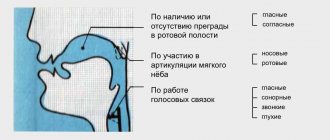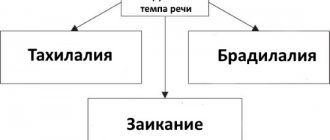Phonetics Basics
Bolycheva E. M.
Sound and letter
Sound is the minimal, indivisible unit of speech flow perceived by the ear. A letter is a graphic designation of a sound in writing, that is, a certain set of lines, a pattern.
The terms “sound” and “letter” must not be mixed. The words what and who are distinguished by the sounds [w] and [k], and not by letters. Sounds are pronounced and heard, letters are written and read. Other relationships are impossible: a letter cannot be pronounced, sung, spoken, recited, it cannot be heard. Letters are neither hard nor soft, nor deaf, nor voiced, nor stressed, nor unstressed. All characteristics given refer to sounds. These sounds are linguistic units, while letters belong to the alphabet and most often have nothing to do with the description of linguistic patterns. It is the quality of the sound that determines the choice of letter, and not vice versa. Sounds exist in any language, whether it is written or not.
Unlike other linguistic units (morphemes, words, phrases, sentences), sound itself has no meaning. At the same time, the existence of sounds is inextricably linked with meaningful units. The function of sounds in language is aimed at ensuring the possibility of communication between people and comes down to the formation and differentiation of morphemes and words.
When determining the distinctiveness of sounds, it is important to understand in what positions they occur. Position refers to the conditions for the pronunciation of sounds, specified by their position in relation to neighboring sounds, to a stressed syllable, to the beginning/end of a word. Only those sounds that have the ability to occur in the same position can distinguish words (morphemes). The difference in the pronunciation of such sounds is noticed by native speakers in contrast to other sound features.
The Russian alphabet is called Cyrillic and has 33 letters. To denote consonant sounds, 21 letters are used: b, v, g, d, g, z, j, k, l, m, n, p, r, s, t, f, x, c, ch, sh, sch. 10 letters are used to denote vowel sounds: a, u, o, y, e, i, yu, e, i, e. There are 2 more letters that do not denote sounds: ъ, ь.
There may be a mirror correspondence between the phonetic and graphic appearance of a word: [volume] volume. However, such a correspondence is not necessary: the word [p'at'] has three sounds, and it is written with four letters - five.
Letters have "multiple meanings", which are removed if adjacent letters/spaces are known. Thus, the letter е in the word fir-tree denotes the sound [j] and the sound [o], in the word heifer - a sign of softness of the consonant ['] and the vowel sound [o], and in the word silk - one vowel sound [o].
Page 1 - 1 of 10 Home |
Prev. | 1 | Track. | End | All © All rights reserved
Vowels of other unstressed syllables
| Climb | Row | ||
| front | average | rear | |
| upper | And | s | at |
| average | b | ъ | |
| lower | |||
| Presence-absence of labialization | non-labialized | labialized |
An example of the articulatory characteristics of vowels: [pnarus] – [a] stressed vowel, lower rise, middle row, non-labialized.
It must be borne in mind that in the linguistic literature there are discrepancies in the articulatory classification of vowels.
The first table of the articulatory characteristics of vowels with the distribution of the latter by row and rise was proposed by N.I. Nadezhdin in 1844.
In 1911, the A.A. vowel table was created. Shakhmatov; it took into account not only the row and rise of vowels, but also the presence - absence of labialization, tension - non-tension of vowels; in this case, only stressed vowels were included in the table.
In the table V.A. Bogoroditsky combines vowels and consonants.
In 1911, the International Phonetic Association was created and improved by L.V. Shcherboy table of articulatory characteristics of vowels characteristic of many languages; this table had the shape of a triangle.
In the table I.A. Baudouin de Courtenay defines vowels according to three types of “extension pipe” (oral cavity). The main vowels in this table are as follows: [a] - the lowest, [u], [i] - the highest; while [y] is the most posterior and labialized, [and] is the most anterior. Each sound is represented as a combination of articulations [a-i-u], for example:
,
The table “Russian linguistic alphabet” was influenced by oriental studies. The table is built on the dichotomous principle of binomial™ of each distinction: the main oppositions in it are rounded-unrounded and front-non-front vowels. Features characterizing consonants are also noted; palatal, laryngeal, labial, dental consonants.
The most detailed table is the “quadrilateral by Daniel Jones”, who used it together with V.P. Trofimov in 1923 to characterize Russian vowels. The table of A.I. turned out to be close to this table. Thomson, proposed in 1906.
"Daniel Jones Quadrangle"
Each point in this table is a special “cell”. No matter how little the articulation of two sounds differs from each other, for each of them in the table you can find a special place - its own point. The difference in articulation is reflected by the arrangement of the dots: one dot is higher, lower, to the right or to the left; another. The bottom side of the quadrilateral is shorter than the top, and the back side is shorter than the front; This reflects the fact that in the lower position the movements of the tongue are more constrained than in the upper, and in the back they are more constrained than in the front.I
In modern linguistic literature, scientific and educational, the articulatory classification of vowels is usually used according to three criteria: rise, row, presence or absence of labialization; in this case, stressed vowels are considered (R.I. Avanesov, K.V. Gorshkova, V.V. Ivanov, V.V. Tsaiukevich, M.I. Matusevich, L.Ya. Malovitsky, etc.). The articulatory characteristics of unstressed vowels are proposed by A.A. Reformatsky, M.V. Panov, L.L. Kasatkin, I.D. Samoilova, and the differences in the proposed classifications are significant: [ъ| absent from M.V. Panova and L.L. Kasatkina; [L] is defined as a middle vowel, back raised, non-labialized M.V. Panov, as a vowel of the middle-low rise, middle-back row, non-labialized L.L. Kasatkin, as a low vowel, middle vowel, non-labialized I.D. Samoilova and the author of this textbook.
An interesting dichotomous scheme proposed by M.V. Panov, but she ignores the difference between the middle and back rows, the middle and lower rises (which is why [a] and [ъ] are not distinguished).
| Vowels | front row | unrounded | top lift | [And] |
| non-top lift | [e] | |||
| rounded | top lift | [y] | ||
| non-front row | non-top lift | [O] | ||
| unrounded | top lift | [s] | ||
| non-top lift | [а], [ъ] |
Basic phonetic processes in the vowel area
Change of vowels depending on position in relation to stress
Reduction
I. In unstressed positions, some vowels coincide in one sound.
In accordance with the stressed vowels [a], [o], [e], the following vowels are pronounced in unstressed syllables:
| First pre-stressed syllable | Other unstressed syllables | ||||
| Positions | After hard consonants | After [f], [w] | After soft consonants | After hard consonants | After soft consonants |
| Sounds | [^] | [ee] | [ie] | [ъ] | [b] |
II. In unstressed positions, vowels are reduced.
Reduction is a phonetic process that consists in weakening and changing the sound of unstressed syllables, primarily the syllabic sounds of these syllables. For the modern Russian language, in which vowels are the syllable-forming sounds, reduction concerns primarily vowels.
The reduction of consonants is manifested in men [ј], which is pronounced immediately before stressed vowels, and , which is pronounced in other positions.
Reduction can also explain the deafening of final voiced consonants.
Reduction can be quantitative and qualitative.
Quantitative reduction is a change in unstressed vowels in their length and tension. All unstressed vowels of the modern Russian language are subject to quantitative reduction.
The relative length and tension of vowels, depending on their position in relation to stress, differs in different languages and even in dialects of the same language.
VOWEL SOUNDS. THEIR CLASSIFICATION. CHANGES IN VOWELS IN SPEECH.
Sound is the smallest insignificant unit of speech flow. Sound appears in speech undifferentiated, as a single whole; It is impossible to isolate individual elements of pronunciation (articulation) from it. The selection of individual sounds is to a certain extent coarsened, because in a stream of speech, sounds follow directly one after another, changing depending on the quality of the preceding or subsequent sound.
All speech sounds are divided into vowels and consonants. The classification of sounds is carried out along two lines: from the point of view of their formation (articulatory classification) and from the point of view of their perception (acoustic classification). The leading one is the articulatory classification of sounds.
Air passing through the respiratory tract encounters two obstacles on its way.
The first obstacle is the vocal cords. If they are tense and shifted, then when the air stream moves, they begin to oscillate and a tone (musical sound) appears. This is how vowel sounds are formed (as well as a number of consonants, in the formation of which the vocal cords take part, for example, sonorant consonants).
If the vocal cords are not moved, they do not vibrate and no tone is produced.
The second obstacle is in the oral cavity - lips, teeth, palate. The lips come close to each other, or the lips with the teeth, the tongue with the palate or the teeth. The air stream overcomes this obstacle, resulting in noise. This is how all consonant sounds are formed.
Thus, the main articulatory difference - the presence of various kinds of obstacles in the formation of vowels and consonants - also determines their other differences, primarily acoustic ones, associated with auditory perception.
The differences between vowels and consonants are due to the localization of sounds. Vowels are non-localized sounds, they do not have a point of contact between the active and passive organs of speech, there is no place of formation. Consonants have a point, a place of interaction between the active and passive organs of speech, which is why they are called localized.
For the formation of vowels, a weak air stream is sufficient, but for consonants, a stronger air stream is needed to overcome the obstacle in the oral cavity.
When vowel sounds are formed, muscle tension is distributed evenly throughout the entire oral cavity. When consonant sounds are formed, muscle tension is concentrated in the place where the obstruction occurs.
According to the figurative expression of V.A. Bogoroditsky, vowels are mouth openers, and consonants are mouth openers. The louder we pronounce vowels, the more we open our mouth; The louder we want to pronounce consonant sounds, the closer the speech organs should be brought together. (Compare sounds [a] and [s])
Articulatory classification of vowel sounds.
Having arisen in the larynx as a result of vibration of the vocal cords, the tone (voice) acquires timbre in the supraglottic cavities due to overtones, i.e. additional tones. The mouth and pharynx are resonators where the difference between vowels is formed.
These differences between vowels are determined by the volume and shape of the resonating cavities. Volume and shape change as a result of movements of the lips and tongue.
Vowels are classified according to three criteria:
1) by elevation (the degree of elevation of the tongue vertically in relation to the hard palate)
2) by row (the degree of horizontal advancement of the tongue forward or pushed back)
3) by the participation of the lips (extension forward and the specific shape of the “ring”)
By rise
There are 3 lifts:
1) upper rise (tongue raised high to the palate) – sounds [i], [s], [u]
2) average rise (the tongue is slightly raised, occupies an average position in relation to the hard palate) - sounds [e], [o].
3) lower rise (the tongue is lowered as much as possible with a wide mouth opening) – sound [a].
By row
There are 3 rows:
1) front row (the body of the tongue is moved forward, the tip of the tongue rests on the lower teeth) – sounds [i], [e].
2) middle row (the body of the tongue seems to be spread out in the oral cavity) - sounds [s], [a].
3) back row (the body of the tongue is moved back) – sounds [u], [o].
By the participation of the lips
Vowels are divided into:
1) labial, or labialized (lips are extended forward and take a specific “ring” shape) – sounds [o], [u].
2) non-labial, or non-labialized (lips are in a neutral position) - [i], [e], [a], [s].
Changing vowels in speech
Changes (modifications) of sounds that arise in speech are expressed in a change in the quality of their sounds. Modifications can be of two types:
1) combinatorial, caused by the interaction of articulations of sounds located in the flow of speech in immediate or close proximity to each other.
2) positional, caused by a certain position of a sound (for example, an unstressed position, the position of the absolute beginning or absolute end of a word)
COMBINATORY CHANGES IN VOWELS
Depending on which sound is affected, the previous or subsequent one, the direction of the change is distinguished:
A) a change in which a subsequent sound is affected by the previous one is called progressive;
B) a change in which the preceding sound is affected by the subsequent one is called regressive.
In the field of Russian vowels (Russian vocalism), such influences are expressed in the influence of the articulations of consonant sounds on the articulations of vowels and are called accommodation (from the Latin accomodatio - “adaptation”)
Specific features of combinatorial modifications in the field of vocalism:
1) the combinatorial effect of consonants on vowels is possible only in the position of vowels under stress.
2) the result of combinatorial modifications of vowels is their acquisition of additional shades of sound.
3) the influence of consonants on vowels is carried out in both progressive and regressive ways, but the most striking and fairly easily recognizable by ear are progressive modifications.
In the flow of speech, vowel sounds can acquire 4 types of combinatorial shades.
1 type. I-shape when a stressed vowel is adjacent to soft consonants. The appearance of a shade is possible in 3 positions: a) after a soft consonant before a hard one [t'a t], b) after a hard consonant before a soft one, c) between soft consonants [t'a t'], where [t] is any consonant, and [a] is any vowel. The i-shape is indicated by a dot above the vowel at the beginning or end of its sound, for example, in the word mint
[m' •a t'],
mother
[m a• t'],
crush
[m' •a• t'].
Vowels with an i-shape are shorter in duration (closed). But not all vowels change the sound quality to the same extent. Only the vowels [у], [о], [а] as non-front vowels are subject to unconditional influence. The front vowels [i], [e] have maximum, extreme brevity of sound, they become sounds of the highest possible rise.
2nd view. A shade of nasalization, when a stressed vowel is adjacent to nasal (nasalized) consonants [m], [m'], [n], [n']. Depending on the location of the nasal consonant, the vowel acquires a nasal resonance at the beginning, end, or at the beginning and end of the articulation: nose
[n nose],
bank
[ban NKъ],
German
[n'nenm'ts].
3rd view. A shade of labialization when a stressed vowel is adjacent to labial (labialized) consonants: [b], [b'], [p], [p'], [m], [m'], [v], [v'], [f], [f']. When the lips are stretched, due to labial articulation, the volume of the front part of the resonator increases, the tone of their pronunciation decreases: dust
[p oyl'],
tempo
[t eo mp]. The naturally labialized vowels [o] and [u] are not labialized.
4th view. A shade of velarization when a stressed vowel is adjacent to hard back-lingual k, g, x, hard front-lingual z, sh, ts, hard front-lingual dental l. Front vowels do not acquire this shade, as they are not combined with hard consonants: year
[g here],
beetle
[w wuv k].
POSITIONAL CHANGES IN VOWELS
Vowels in unstressed positions undergo positional modifications. Unstressed vowels in the Russian language are reduced. Reduction is the shortening of the duration of a sound. In the Russian language, it is customary to distinguish between quantitative (by the length of the sound) and qualitative (by the nature of the sound) reduction.
The degree of reduction depends on the place of the vowel in relation to the stressed syllable, as well as on the natural characteristics of the vowel: the lower vowel a is subject to the greatest degree of reduction, and the least susceptible are the upper vowels i, ы, у.
There are 2 degrees of reduction. Reduction of the first degree is characteristic of the sounds of the first pre-stressed syllable and the absolute beginning of the word. Reduction of the second degree is characterized by a sharp reduction in duration and noticeable changes in the nature of the sound of vowels. It affects vowels in all over-stressed syllables, as well as in pre-stressed ones located at a considerable distance from the stressed syllable (except for the 1st pre-stressed and absolute beginning of the word). Let's graphically represent the sound structure of the word phonetic
- [sasas
a sassasa],
II I II II II
where we denote any consonant [s], and any vowel [a]. The stressed vowel is underlined and in bold, and degrees of reduction are indicated in Latin numerals.
It should be noted that the vowels of the upper rise [i, ы, у] undergo only quantitative changes - they become shorter in the unstressed position, less tense - they do not change qualitatively. Non-high vowels [a, o, e] undergo not only quantitative, but also qualitative changes.
There are special designations for them:
[/\] – “lid”, “hut”
[ie] – “and with overtones e”
[ые] – “ы with the sound e”
[ъ] – “er”
[b] – “er”
The first three signs are used to designate sounds of non-upper rise [e, o, a] in 1 weak position (I degree of reduction), and the last two [ъ] and [ь] - to designate unstressed super-short vowels in 2 weak position (II degree of reduction ).
All unstressed vowels become closer in sound
~ to [a] – moderate akanye,
~ k [s] – moderate whining,
~ to [and] – moderate hiccups.
~ a = [/\] (I degree of reduction) and [ъ] (II degree of reduction) – modification of the sounds [o] and [a] ( in [/\]da, in [ъ]dyanoy
)
~ ы = [ые] (I degree of reduction) and [ъ] (II degree of reduction) – modification of the sounds [a], [e] after hard consonants (zh [ye]na, background [ye]tic, sh[ъ] crusty
)
~ [i]= [ie] (I degree of reduction) and [b] (II degree of reduction) – modification of the sounds [e] and [a] after soft consonants ( l[ie]snik, ice[ie]noy, shch[ b]b[ie]t
)
Positional changes in non-high vowels can be presented in the form of a table
| After TV acc. | I st. ed. | II Art. ed. | After soft agreement | I Art. ed. | II st.ed. |
| [A] | [/\] | [ъ] | '[A] | [ie] | [b] |
| [O] | [/\] | [ъ] | '[O] | — | — |
| [e] | [ee] | [ъ] | '[uh] | [ie] | [b] |








